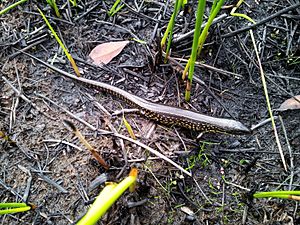Blue Mountains water skink facts for kids
Quick facts for kids Blue Mountains water skink |
|
|---|---|
 |
|
| Conservation status | |
| Scientific classification | |
| Genus: |
Eulamprus
|
| Species: |
leuraensis
|
The Blue Mountains water skink (Eulamprus leuraensis) is a special kind of skink found only in Australia. It's also called the Blue Mountains swamp-skink. This small lizard is an endangered species, meaning there aren't many left in the wild. It lives only in certain swampy areas of the Blue Mountains in southeastern Australia.
What Does It Look Like?
The Blue Mountains water skink is a small lizard. Its body, from its snout to where its tail begins, is about 80 millimeters (3 inches) long. Its tail is even longer, about 120 millimeters (4.7 inches).
Its head is a mix of bronze and brown, with some black marks. The top of its body is dark brown or black. Along its back, on both sides of its spine, you can see rows of tiny yellowish-bronze or white spots. These spots look like faint lines. These lines of spots continue onto its dark tail.
The sides of its body and its legs are dark brown or black, with yellowish or bronze patterns. Its belly is cream or yellow with small dark spots. It has strong legs and five toes on each foot. This skink looks darker overall than other skinks in the Eulamprus group, which helps tell it apart.
Where Does It Live?
This skink is endemic to the Blue Mountains in New South Wales, Australia. This means it lives naturally only in this area and nowhere else in the world.
There are two main groups of these skinks. One group lives on the Newnes Plateau. The other group lives on the opposite side of the mountains, near Hazelbrook. These two main groups are split into about 40 smaller places where the skinks are found.
They love to live in swampy areas. These swamps have lots of sedges (grass-like plants) and small shrubs. They live at heights between 560 and 1060 meters (about 1,800 to 3,500 feet) above sea level. Scientists have studied these skinks and found that the groups are quite separate. Skinks don't move much between these different locations. When they do move, it seems to be mostly the males.
How Does It Live?
The Blue Mountains water skink is one of about 400 animal species found in the Greater Blue Mountains Area. This area is a World Heritage Site recognized by UNESCO. It's famous for its peaks, plateaus, and deep valleys. It's very important because it shows a lot of Australia's amazing variety of life. It even has 91 different types of Eucalyptus trees!
This skink is semi-aquatic, which means it spends time both in water and on land. You can usually see them from September to April. They enjoy basking in the sun to warm up.
They hunt for their food, eating insects like flies, grasshoppers, moths, weevils, and wasps. Sometimes, they might even eat small fruits. Female skinks are viviparous. This means they give birth to live young, instead of laying eggs. This usually happens in the Australian summer, around December.
Why Is It Endangered?
The Blue Mountains water skink (E. leuraensis) is listed as "endangered" by the International Union for Conservation of Nature. This organization keeps track of animals and plants around the world that are at risk. Being endangered means this skink faces a very high risk of disappearing forever if we don't protect it.


